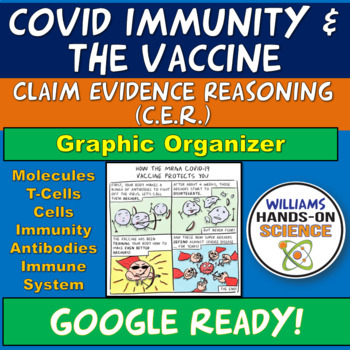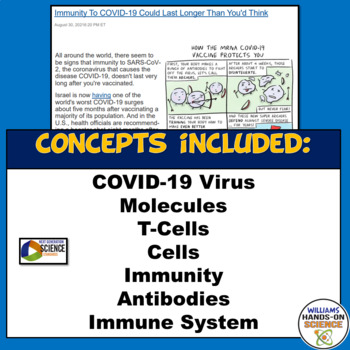COVID Vaccine & Immunity NGSS Claim Evidence Reasoning CER Digital
- Zip
- Google Apps™

Description
Students learn how the vaccine causes the body to gain immunity from COVID-19 through a C.E.R. (Claim Evidence Reasoning) graphic organizer. This is great for getting your students to explain phenomena in a meaningful way and it allows you as the instructor to adequately assess their understanding of concepts. The students figure out what the "Claim" is in the article, they then use data that supports the claim in the "Evidence" section, draw visual evidence and then explain why the evidence supports the claim in the "Reasoning" section.
I recommend this resource for high achieving middle schoolers or high school.
The article has the following concepts:
COVID-19 Virus
Molecules
T-Cells
Cells
Immunity
Antibodies
Immune System
Take a look at my CER Mega bundle!
Related Products:
Coronavirus Claim Evidence Reasoning Google Ready COVID Invades Cells
Google Coronavirus Molecule Structure Claim Evidence Reasoning Distance Learning
How The COVID Vaccine Works Claim Evidence Reasoning CER Google Ready
Claim Evidence Reasoning Graphic Organizer C.E.R. Common Core NGSS
This is great for a current event, sub plan, homework, critical thinking, scaffolding and/or reinforcement of concepts!
You get a CER graphic organizer, an editable key, the article, tips for CER and the link to the website in the article.
NGSS DCI for middle school:
PS1.A: Structure and Properties of Matter
•Substances are made from different types of atoms, which combine with one another in various ways. Atoms form molecules that range in size from two to thousands of atoms. (MS-PS1-1)
MS-LS1-1
Conduct an investigation to provide evidence that living things are made of cells; either one cell or many different numbers and types of cells. Emphasis is on developing evidence that living things are made of cells, distinguishing between living and non-living cells, and understanding that living things may be made of one cell or many and varied cells.
MS-LS1-2
Develop and use a model to describe the function of a cell as a whole and ways the parts of cells contribute to the function. Emphasis is on the cell functioning as a whole system and the primary role of identified parts of the cell, specifically the nucleus, chloroplasts, mitochondria, cell membrane, and cell wall. Assessment of organelle structure/function relationships is limited to the cell wall and cell membrane. Assessment of the function of the other organelles is limited to their relationship to the whole cell. Assessment does not include the biochemical function of cells or cell parts.
•Use argument supported by evidence for how the body is a system of interacting subsystems composed of groups of cells. Emphasis is on the conceptual understanding that cells form tissues and tissues form organs specialized for particular body functions. Examples could include the interaction of subsystems within a system and the normal functioning of those systems. Assessment does not include the mechanism of one body system independent of others. Assessment is limited to the circulatory, excretory, digestive, respiratory, muscular, and nervous systems.
NGSS Performance Expectation for High School:
LS1.A: Structure and Function
•Systems of specialized cells within organisms help them perform the essential functions of life. (HS-LS1-1)
•All cells contain genetic information in the form of DNA molecules. Genes are regions in the DNA that contain the instructions that code for the formation of proteins. (HS-LS1-1) (Note: This Disciplinary Core Idea is also addressed by HS-LS3-1.)
NGSS Standards:
SEP's Asking Questions and Defining Problem:
Students at any grade level should be able to ask questions of each other about the texts they read, the features of the phenomena they observe, and the conclusions they draw from their models or scientific investigations.
Engaging in Argument from Evidence:
In 9–12 builds on K–8 experiences and progresses to using appropriate and sufficient evidence and scientific reasoning to defend and critique claims and explanations about the natural and designed world(s). Arguments may also come from current scientific or historical episodes in science.
CCC's: Patterns
Observed patterns of forms and events guide organization and classification, and they prompt questions about relationships and the factors that influence them.
TERMS OF USE
• All rights reserved by Williams Hands On Science, Inc.
• This product is to be used by the original purchaser only.
• Intended for classroom and personal use only.
• Copying for more than one teacher, classroom, department, school, or school system is prohibited.
• This product may not be distributed or displayed digitally for public view.
• Failure to comply is a copyright infringement and a violation of the Digital Millennium Copyright Act (DMCA).
If there are any errors or questions, please contact me through TpT or email me at:
williamshandsonscience@gmail.com
Thank you for taking a look!
Please follow me on TpT for new products and check me out on Instagram for my products in action!





